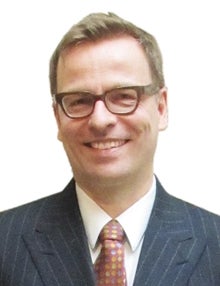Matthias Waschek
DIRECTOR, Worcester Art Museum
HOME COUNTRY: Germany
RESIDENCE: Worcester
EDUCATION: Ph.D, Bonn University
Two months ago, Matthias Waschek took the helm as director of the 116-year-old Worcester Art Museum, replacing James Welu, who is director emeritus after being a fixture at the museum for nearly 40 years, the last 25 as director. Here, Wascheck talks about his new job and the role of the museum in the fabric of the Worcester area.
You’ve now been in the job a couple of months. How’s it going?
It’s wonderful because … there are all these wonderful opportunities and the museum has as you know a phenomenal collection, a phenomenal staff. It’s now all about how we’re going to write the next chapter in this institution.
The last one was a pretty long one.
It’s a long chapter and it was a very good one for the museum, so the pressure’s on (laughs) to write an equally good one for the museum now. Every generation has a different take on what a museum is in addition to collecting art because that’s always what’s going to happen: to collect and to show art. How you show it, whom you engage, where you put your priorities – that is defined afresh by every generation of museum directors, every generation of curators. And so I will come with my own focal points and with my own ways of engaging with the staff as well.
You’re coming in at a different time (following Welu’s long tenure). Do you see yourself as having to attract a new generation of patrons?
It’s not only a new generation, it’s also (new) geographically, with a broader footprint. When you think about it, Worcester went through some changes ever since World War II with the change (in) manufacturing. A lot of the old money left town and the museum was built on that old money. And that has changed. Jim was probably in the transitory period but still, as far as I understand it, very much focused on Worcester rather than on the Boston region. I think this is the step that we need to make now, both in terms of visitors and board members.
And in that new step, we have to be very aware that the roots of this museum are in Worcester and that this institution remains deeply rooted here. I think that in that new chapter, we should align ourselves with the strategic plan of the city of Worcester. We should have an impact on the urban fabric, thinking about our immediate environment as well.
How can you do that?
Well, I’ll give you one example. This is a dream rather than reality. When you think about our parking lot, for instance, parking lots are urban nightmares. Our parking lot is a nightmare as much as any parking lot is. But we have art. So could we not combine a sculpture park with a parking lot so people, when they come onto the parking lot, understand that they’re in an arts space? Something like that.
Your professional experience is rooted heavily in Europe, especially France. How do you compare the American approach to appreciating art with that of Europe?
In Europe, art is seen as something that is paid for by the state or the city. So it’s publicly paid for. In America, (art) is, with some exceptions, more of a private thing. That is one of the very important differences. I think also due to the size of America and due to the diversity of America, the attitude toward museums is much more fractured.
Museums are more part of the social glue of society in Europe than they seem to be here. And I’m making a very sweeping comment and I have to be very careful about that, but you can still quote me.
You’ve been an educator as well as an administrator. Does each role help inform the other?
In a specific field like the museum, definitely, because if you know how an educator is in the sense of museum educational service or a curator functions, your decisions are much more nuanced. So in that sense, the knowledge of curatorial and education practice very much informs your priorities and the way you strategize.
How does an art museum benefit the business sector of its community?
There are lots of numbers that are swelling around. What museums in certain cases do is they participate in a synergy -psychologically speaking – so people … generate foot traffic. They can have a visual impact as well on the urban setout of the town … and all these have economic consequences. I’m not well versed in this enough to have an understanding as to how exactly you can measure that because there are too many other factors that, once a museum gets traction, kick into place. You can’t credit all of that to the museum. But museums can be part of a driving force in urban reconstruction.
True or false: Art is a business as much as it is a cultural cornerstone. And why?
Art can be a business. Artists can market themselves very well, and other artists don’t market themselves very well and are still great artists. Vincent Van Gogh was, by marketing standards, one of the least savvy artists you could possibly imagine. Afterwards his work became a business. So you can produce great art without having an impact on the market, as we know with the romantic artist who lives in his attic and almost starves, but keeps painting.

